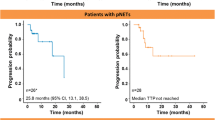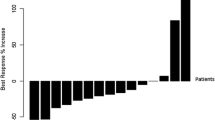Abstract
The two hormone analogues octreotide and goserelin have been shown to decelerate growth of human pancreatic cancer in vitro and in vivo. The objective of this pilot study was to investigate the efficacy and toxicity of the combination of these two agents in patients with advanced pancreatic cancer. Octreotide was injected subcutaneously in dosages increasing weekly, starting with 50 μg twice daily, until the level of maintenance therapy of 500 μg three times a day was reached. In addition, 3.8 mg goserelin acetate was administered subcutaneously at monthly intervals. A median of 7 cycles (range 1–27 cycles) were applied; 13 out of 14 patients entered into the study were evaluable for response and all 14 were evaluated for toxicity. In one patient with initially non-resectable pancreatic cancer, systemic therapy yielded a partial remission lasting 9 months. The degree of tumour regression then allowed a consecutive macroscopic radical tumour resection followed by an additional 6 months of no evidence of disease while the same drug combination was continued. In an additional 9 patients, no change of disease was observed, in some cases for a remarkably long time (up to 27 months). Nevertheless, the objective response rate of 7% (95% confidence interval 0±21%) was low. In 5 patients a clear improvement in their performance status was seen soon after the start of therapy; 3 patients showed progression of the disease at first evaluation or earlier and 1 patient was not evaluable at the time of study assessment. According to the product-limit method of Kaplan and Meier, the time to progression was 3.0±1.8 months [median±asymptotic standard error (ASE)] and overall survival was 6.0±1.5 months (median±ASE). Toxicity was rare and only of mild to moderate degree. Overall, the regimen under investigation did not meet the criteria for sufficient antitumoural effectiveness. Nevertheless, this study reinforces the concept that pancreatic cancer is principally responsive to endocrine therapy and therefore the further investigation of hormonal manipulation seems worth while in the future.
Similar content being viewed by others
Abbreviations
- ASE :
-
asymptotic standard error
References
Allegretti A, Lionetto R, Saccomanno S, Paganuzzi M, Onetto M, Martinoli C, Rollandi G, Marugo M, Fazzuoli L, Pugliese V et il gruoppo Ligure per lo studio del pancreas (1993) LH-RH analogue treatment of adenocarcinoma of the pancreas: a phase II study. Oncology 50:77–80
Andren-Sandberg A (1989) Androgen influence on exocrine pancreatic cancer. Int J Pancreatol 4:363–369
Bauer W, Briner U, Doepfner W (1982) SMS 201-995: a very potent and selective octapeptide analogue of somatostatin with prolonged action. Life Sci 31:1133–1140
Büchler M, Kübel R, Klapdor R (1989) Immunotherapy of pancreatic cancer with monoclonal antibody BW494: results from a multicentric phase I–II trial. In: Beger HG, Büchler M, Reisfeld RA, Schulz G (eds) Cancer therapy. Springer, Berlin Heidelberg New York, pp 32–47
Canobbio L, Boccardo F, Cannata D, Gallotti P, Epis R (1992) Treatment of advanced pancreatic cancer with the somatostatin analogue BIM 23014. Cancer 69:648–650
Cascinu S, Del Ferro E, Catalano G (1995) A randomised trial of octreotide vs best supportive care only in advanced cancer patients refractory to chemotherapy. Br J Cancer 71:97–101
Corbishley TP, Iqbal MJ, Johnson PJ, Williams R (1984) Progesterone receptors in malignant and foetal pancreatic tissue. IRCS Med Sci 12:575–576
Corbishley TP, Iqbal MJ, Wilkinson ML, Williams R (1986) Androgen receptor in human and malignant pancreatic tissue and cell lines. Cancer 57:1992–1995
Del Pozo E, Neufeld K, Schlütter F (1986) Endocrine profile of a long-acting somatostatin derivate SMS 201-995. Study in normal volunteers following subcutaneous administration. Acta Endocrinol 111:433–499
Fekete M, Zalatnai A, Comaru-Schally AM, Schally AV (1989a) Membrane receptors for peptides in experimental and human pancreatic cancers. Pancreas 4:521–528
Fekete M, Zalatnai A, Schally AV (1989b) Presence of membrane binding sites for (d-TRP6)-luteinizing hormone-releasing hormone in experimental pancreatic cancer. Cancer Lett 45:87–91
Frieß H, Büchler M, Krüger M, Beger HG (1992) Treatment of duct carcinoma of the pancreas with the LH-RH analogue buserelin. Pancreas 7:516–521
Frieß H, Büchler M, Beglinger Ch, Weber A, Kunz J, Fritsch K, Beger HG (1993a) Low dose octreotide treatment is not effective in patients with advanced pancreatic cancer. Pancreas 8:540–545
Frieß H, Büchler M, Ebert M, Malfertheiner P, Dennler HJ, Beger HG (1993b) Treatment of advanced pancreatic cancer with high dose octreotide. Int J Pancreatol 14:290–291
Gonzalez-Barcena D, Ibarra-Olmos MA, Garcia-Carrasco F, Gutierrez-Samperso C, Comaru-Schally AM, Schally AV (1989) Influence ofd-Trp-6-LH-RH on the survival time in patients with advanced pancreatic cancer. Biomed Pharmacother 43:313–317
Greenway B, Iqubal MJ, Johnson PJ & Williams R (1981) Oestrogen receptor proteins in malignant and fetal pancreas. Br Med J 283:751–753
Hanna WT and Maull KI (1990) Sandostatin-induced thrombocytopenia. South Med J 83:77
Hierowski MT, Liebow C, Dusapin K, Schally AV (1985) Stimulation by somatostatin of dephosphorylation of membrane proteins in pancreatic cancer MIAPa CA2 cell lines. FEBS Lett 179:252–256
Huguier M, Samama G, Testart J, Mauban S, Fingerhut A, Nassar J, Houry S, Jaeck D, De Mestier P, Favre JP, Michot F, Vidrequin A, Mantion G, Veyrieres M, Fourtanier G, Lointier P, Gignoux M (1992) Treatment of adenocarcinoma of the pancreas with somatostatin and gonadoliberin (luteinizing hormone-releasing hormone). Am J Surg 146:348–353
Klijn JGM, Setyono-Han B, Bakker GH, Henkelman MS, Portengen H, Foekens JA (1987) Effects of somatostatin analog (Sandostatin) treatment in experimental and human cancer. In: Klijn JGM, Paridaens R, Foekens JA (eds) Hormonal manipulation of cancer: peptides, growth factors and new (anti) steroidal agents. (EORTC monograph series, vol 18) Raven, New York, pp 459–468
Klijn JGM, Hoff AM, Planting ASTh, Verweij J, Kok T, Lamberts SWJ, Portengen H, Foekens JA (1990) Treatment of patients with metastatic pancreatic and gastrointestinal tumors with the somatostatin analogue Sandostatin: a phase II study including endocrine effects. Br J Cancer 62:627–630
Lamberts SWJ, Van der Lely AJ, De Herder WW, Hofland LJ (1996) Octreotide. N Engl J Med 334:246–254
Miller AB, Hoogstraten B, Staquet M, Winkler A (1981) Reporting results of cancer treatment. Cancer 47:207–214
Redding TW, Schally AV (1984) Inhibition of growth of pancreatic carcinomas in animal models by analogs of hypothalamic hormones. Proc Natl Acad Sci USA 81:248–252
Reubi JC, Horisberger U, Essed CE, Jeekel J, Klijn JGH, Lamberts SWJ (1988) Absence of somatostatin receptors in human exocrine pancreatic adenocarcinomas. Gastroenterology 95:760–763
Rosenberg L, Barkun AN, Denis MH, Pollak M (1995) Low dose octreotide and tamoxifen in the treatment of adenocarcinoma of the pancreas. Cancer 75:23–28
Scambia G, Benedetti BP, Baiocchi G, Perrone L, Iacobelli S, Mancuso S (1988) Antiproliferative effects of somatostatin analog SMS 201-995 on three human breast cancer cell lines. J Cancer Res Clin Oncol 144:106–108
Schally AV (1988) Oncological applications of somatostatin analogues. Cancer Res 48:6977–6985
Serrano MJ, Liebow C, Reilly C, Shally AV (1988) LH-RH analogue causes direct inhibition of growth of pancreatic cancer cells in culture. Pancreas 3:617
Sperti C, Fasquali C, Catalini S, Alfano D'Andrea A, Militello C, Piccoli A, Pedrazzoli S (1992) Hormonal treatment of advanced pancreatic cancer with LH-RH analogue. European J Surg Oncol 18:267–271
Suri P, Lipton A, Harvey HA, Wyszynski E, Dixon R, Hamilton RW (1991) Hormonal treatment of pancreatic carcinoma with GNRH and somatostatin analogs. Proc Am Soc Clin Oncol 10:302
Szende B, Srkalovic G, Timar J, Mulchahey JJ, Neill JD, Lapis K, Csikos A, Szenpeshazi K, Schally A (1991) Localization of receptors for luteinizing hormone-releasing hormone in pancreatic and mammary cancer cells. Proc Natl Acad Sci USA 88:4153–4156
UICC International Union against Cancer (1987) TNM Klassifikation maligner Tumoren, vol 4. Springer, Berlin Heidelberg New York
Wagener DJTh, Mulder PHM de, Wils JA (1994) Multimodality treatment of locally advanced pancreatic cancer. Annal Oncol 5 [Suppl 3]: 81–86
Wagener DJTh, Verdonk HER, Dirix LY, Catimel G, Siegenthaler P, Buitenhuis M, Methieu-Boué, Verweij J (1995) Phase II trial of CPT-11 in patients with advanced pancreatic cancer, an EORTC early clinical trials group study. Ann Oncol 6:129–132
Wong A and Chan A (1993) Survival benefit of tamoxifen therapy in adenocarcinoma of pancreas. Cancer 71:2200–2203
World Health Organization (WHO) (1990) International classification of disease for oncology, 2nd edn WHO, Geneva
Yamada Y, Kagimoto S, Kubota A, Yasuda K, Masuda K, Someya A, Ihara Y, Li Q, Imura H, Seino S, Seino Y (1993) Cloning, functional expression and pharmacological characterization of a fourth (hSSTR4) and a fifth (hSSTR5) human somatostatin receptor subtype. Biochem Biophys Res Commun 2:844–852
Zalatnai A, Schally AV (1989) Treatment ofN-nitrosobis(2-oxopropyl)amine-induced pancreatic cancer in Syrian golden hamsters withd-Trp-6-LH-RH and somatostatin analogue RC-160 microcapsules. Cancer Res 49:1810–1815
Author information
Authors and Affiliations
Rights and permissions
About this article
Cite this article
Fazeny, B., Baur, M., Prohaska, M. et al. Octreotide combined with goserelin in the therapy of advanced pancreatic cancer-results of a pilot study and review of the literature. J Cancer Res Clin Oncol 123, 45–52 (1997). https://doi.org/10.1007/BF01212614
Received:
Accepted:
Issue Date:
DOI: https://doi.org/10.1007/BF01212614




